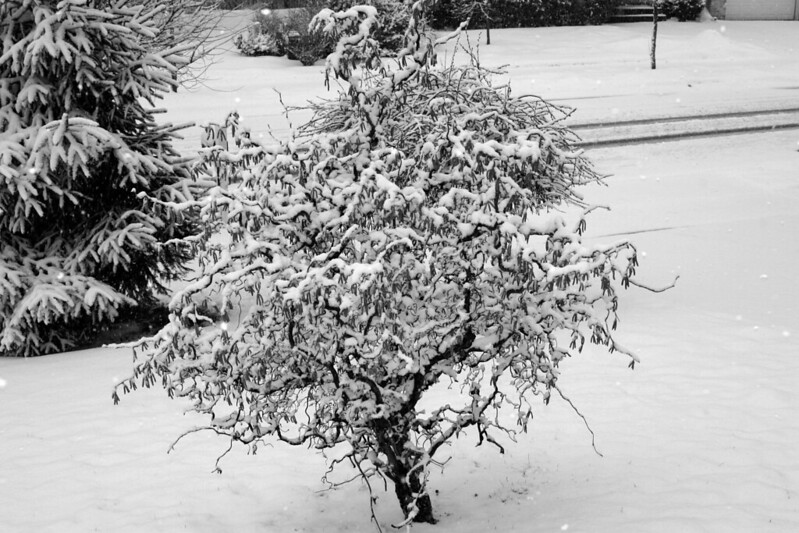One distinct challenge about living in Alaska is making the landscape appealing in the winter. Deciduous shrubs lose their leaves, there’s very little color, and everything is covered by a blanket of snow. Challenging, but by no means impossible. To create a vibrant and interesting winter landscape, consider the following:
Color
 Winterberry (Ilex verticillata) is a deciduous holly which is decorated by bright red berries from summer through winter. For beautiful berries, Cranberry Cotoneaster (Cotoneaster apiculatus) is another great choice. A deciduous low hedge or groundcover formed by spreading branches. Not only do berries provide great color in the yard, but they are also a valuable food source for birds, which also brighten up the landscape.
Winterberry (Ilex verticillata) is a deciduous holly which is decorated by bright red berries from summer through winter. For beautiful berries, Cranberry Cotoneaster (Cotoneaster apiculatus) is another great choice. A deciduous low hedge or groundcover formed by spreading branches. Not only do berries provide great color in the yard, but they are also a valuable food source for birds, which also brighten up the landscape.
The Blue Spruce family (Picea pungens), with its gorgeous silvery blue color, provides interesting color and textural contrast year-round.
Vivid bark is a lovely backdrop to the white snows. Coral Bark Japanese Maple (Acer palmatum ‘Sango Kaku’) is a beautiful small tree which has brilliant red-coral bark on its young branches that intensifies in the winter. The reddish bark of the Prairie fire Crabapple (Malus ‘Prairie Fire’) is complemented by dark purplish red fruit which dangle from the tree in the winter months for birds and other wildlife to enjoy. Red Twig Dogwood (Cornus alba ‘Elegantissima’) will wake up your winter landscaping with its bright red branches. They look fantastic when planted in groups, or as an informal hedge. It is a broadleaf, deciduous shrub which grow in hardiness zones 3-8 and prefer wet, acidic soil. Perfect for SE Alaska! If you’ve already planted shrubs with red berries, opt for a Yellow Twig Dogwood (Cornus sericea ‘Flaviramea’) for an added pop of color.
Shape
Weeping trees add interest to an otherwise drab winter landscape. They typically have a leader which grows straight up and all the other branches hang down, giving it an unusual silhouette. Weeping Cherry (Prunus subhirtella ‘Pendula’) and Beech (Fagus sylvatica) are two deciduous examples that do well down to zone 4.  Weeping White Pine (Pinus strobus ‘Pendula’) is an excellent evergreen example. Additionally, its pine cones act as ornaments on the tree and provide food for birds.
Weeping White Pine (Pinus strobus ‘Pendula’) is an excellent evergreen example. Additionally, its pine cones act as ornaments on the tree and provide food for birds.
Another option for adding interesting shapes and silhouettes are contorted specimens, like the evergreen Contorted White Pine (Pinus strobus ‘Contorta’) and the deciduous Contorted Filbert or Harry Lauder’s Walking Stick (Corylus avellana ‘Red Majestic’). They have a twisted trunk and branches that are fun in the landscape year-round.
Photo credit: https://www.flickr.com/photos/sensual_shadows_photography/74411433
Don’t forget about the Dwarf Alberta Spruce (Picea glauca var. albertiana ‘Conica’). It is a favorite for its evergreen dense growth, small needles, and nearly perfect cone-shape habit. Easily grown and maintained, and grows in zone 3.
Texture
Evergreen trees and shrubs provide textures with their leaves and needles, and planting evergreens with contrasting textures creates interesting compositions. Canadian Hemlock (Tsuga Canadensis) has arching, almost feathery new growth. It’s also a winner because it doesn’t mind a bit of shade and prefers moist soil.
The Alaska Paper Birch (Betula papyrifera) is noted for its white bark, which exfoliates in papery strips to reveal an orange-brown inner bark photo credit: https://commons.wikimedia.org/wiki/File:Betula_papyrifera_(Paper_Birch)_(32080171872).jpg
photo credit: https://commons.wikimedia.org/wiki/File:Betula_papyrifera_(Paper_Birch)_(32080171872).jpg
Although many gardeners like to deadhead spent flowers in the fall, dried blooms and seed heads of sedums, astilbes, and black-eyed susans enrich the winter landscape. The dried flowers of hydrangeas and pieris also add a nice texture to the garden, and look particularly beautiful when dusted with snow.
Using color, shape and texture you can add visual interest to your winter garden, making it enjoyable year-round. I have listed some of my favorite choices, but there are many varieties available. Just take care to choose those plants which will grow in your specific hardiness zone and growing conditions. Be sure to add varying heights, colors and textures, and mix deciduous plants with evergreens to make a pleasing landscape.
